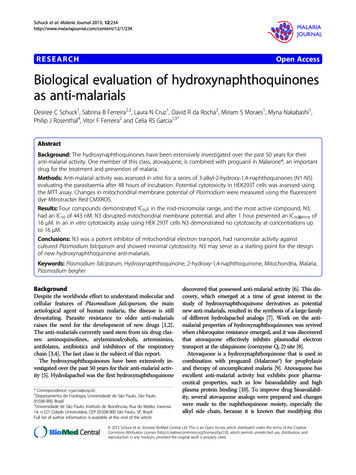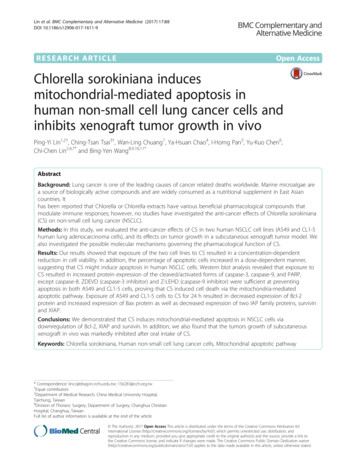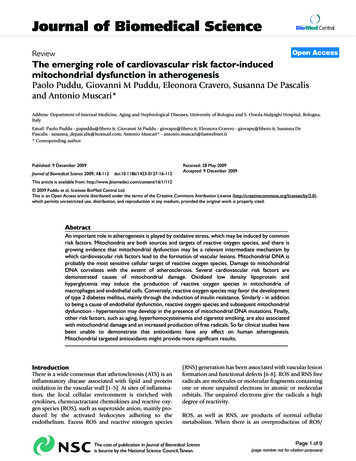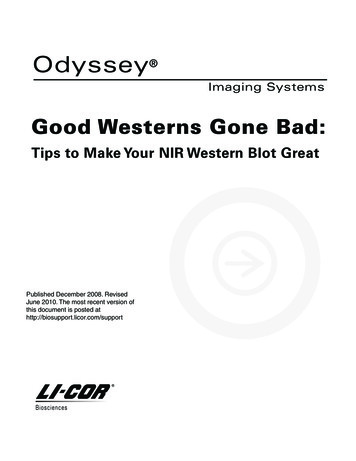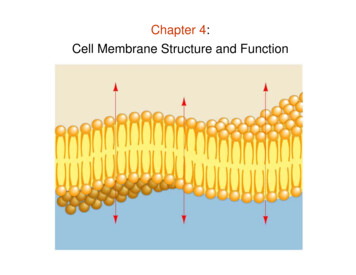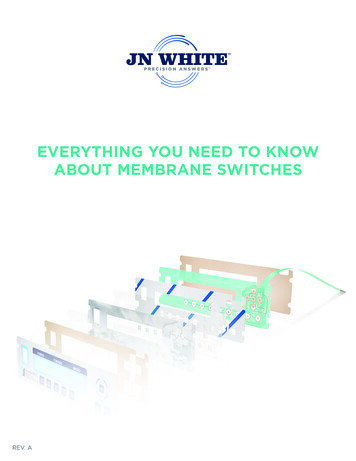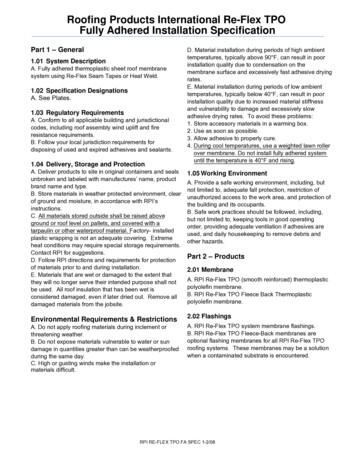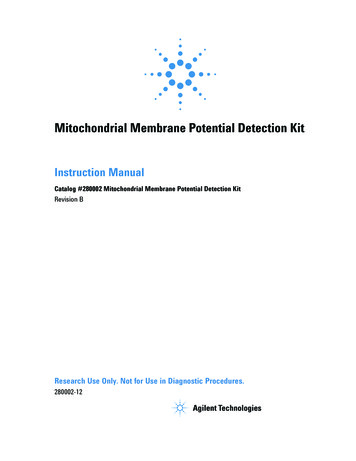
Transcription
Mitochondrial Membrane Potential Detection KitInstruction ManualCatalog #280002 Mitochondrial Membrane Potential Detection KitRevision BResearch Use Only. Not for Use in Diagnostic Procedures.280002-12
LIMITED PRODUCT WARRANTYThis warranty limits our liability to replacement of this product. No other warranties of any kind, expressor implied, including without limitation, implied warranties of merchantability or fitness for a particularpurpose, are provided by Agilent. Agilent shall have no liability for any direct, indirect, consequential, orincidental damages arising out of the use, the results of use, or the inability to use this product.ORDERING INFORMATION AND TECHNICAL SERVICESUnited States and CanadaAgilent TechnologiesStratagene Products Division11011 North Torrey Pines RoadLa Jolla, CA 92037Telephone(858) 373-6300Order Toll Free(800) 424-5444Technical Services (800) 894-1304Emailtechservices@agilent.comWorld Wide Web tria01 25125 6800Benelux02 404 92 22Denmark45 70 13 00 30Finland010 802 220France0810 446 446Germany0800 603 1000Italy800 012575Netherlands020 547 2600Spain901 11 68 90Sweden08 506 4 8960Switzerland0848 8035 60UK/Ireland0845 712 5292All Other CountriesPlease contact your local distributor. A complete list of distributors is available at www.genomics.agilent.com.
Mitochondrial Membrane Potential Detection KitCONTENTSMaterials Provided . 1Storage Conditions . 1Additional Materials Required . 1Introduction . 2Preprotocol Considerations . 3Preparing the JC-1 Reagent . 3Preparing the 10 Assay Buffer . 3Staining Protocol for Flow Cytometry . 4Inducing the Cells . 4Staining the Cells. 4Analyzing the Cells . 5Suspension Cell Staining Protocol for Fluorescence Microscopy . 6Inducing the Cells . 6Staining the Cells. 6Analyzing the Cells . 7Staining Protocol for Fluorescence Ratio Detection7,8 . 7Monolayer Cell Staining Protocol for Fluorescence Microscopy . 8Inducing the Cells . 8Staining the Cells. 8Analyzing the Cells . 8Troubleshooting . 9Preparation of Reagents . 9References . 9Endnotes . 9MSDS Information . 9Staining Quick-Reference Protocol for Flow Cytometry . 10
Mitochondrial Membrane Potential Detection KitMATERIALS PROVIDEDMaterials providedaJC-1 reagent (lyophilized)aQuantity1 tube10 assay buffer60 mlThe Mitochondrial membrane potential detection kit provides sufficient reagents for 100 reactions.STORAGE CONDITIONSJC-1 reagent: Store the JC-1 reagent at –20 C, protected from light and moisture(preferably in a desiccator). Once reconstituted, full activity is guaranteed for 6 months.Avoid subjecting the reconstituted reagent to multiple freeze-thaw cycles by dispensinginto small working aliquots.10 Assay Buffer: Store the 10 Assay buffer at 4 C upon receipt.ADDITIONAL MATERIALS REQUIREDPhosphate-buffered saline (PBS; see Preparation of Reagents)Dimethyl sulfoxide (DMSO)Flow cytometer, fluorescence microscope, or fluorescence plate readerRevision BMitochondrial Membrane Potential Detection Kit Agilent Technologies, Inc. 2010.1
INTRODUCTIONThe mitochondrial permeability transition is an important step in theinduction of cellular apoptosis. During this process, the electrochemicalgradient (referred to as ΔΨ) across the mitochondrial membrane collapses.The collapse is thought to occur through the formation of pores in themitochondria by dimerized Bax or activated Bid, Bak, or Bad proteins.Activation of these pro-apoptotic proteins is accompanied by the release ofcytochrome c into the cytoplasm, which promotes the activation of caspases,which are directly responsible for apoptosis.1–4The Mitochondrial membrane potential detection kit uses a bocyanine iodide), to signal the loss ofmitochondrial membrane potential.5 In healthy non-apoptotic cells, the dyestains the mitochondria bright red.6 The negative charge established by theintact mitochondrial membrane potential allows the lipophilic dye, bearing adelocalized positive charge, to enter the mitochondrial matrix where itaccumulates. When the critical concentration is exceeded, J-aggregates formwhich become fluorescent red. Whereas, in apoptotic cells, themitochondrial membrane potential collapses, and the JC-1 cannotaccumulate within the mitochondria. In these cells JC-1 remains in thecytoplasm in a green fluorescent monomeric form. Apoptotic cells, showingprimarily green fluorescence, are easily differentiated from healthy cellswhich show red and green fluorescence (see Figure 1). The aggregate redform has absorption/emission maxima of 585/590 nm.5 The greenmonomeric form has absorption/ emission maxima of 510/527 nm. The JC-1monomers and aggregates give strong positive signals, capable of yieldingboth qualitative and quantitative results. Detection methods include flowcytometry, fluorescence microscopy, and a fluorescent 96-well plate readerformat.ABFIGURE 1 Jurkat cells were stimulated with (A) DMSO or (B) 1.5 μM staurosporine for 3 hours. The cells were thenlabeled with the JC-1 reagent for 15 minutes. After washing, cell fluorescence was measured on a flow cytometerusing FL1 and FL2 channels.2Mitochondrial Membrane Potential Detection Kit
PREPROTOCOL CONSIDERATIONSPreparing the JC-1 Reagent1.Reconstitute the lyophilized JC-1 reagent with 500 μl of DMSO toobtain a 100 stock solution. Mix by inverting the vial several times atroom temperature until the lyophilized contents are completelydissolved.2.Aliquot the reconstituted JC-1 reagent in small amounts sufficient forone day of experimental work and store the remainder at -20 C inamber vials, away from moisture and light.3.Immediately before use, dilute the 100 JC-1 reagent 1:100 in 1 assaybuffer, or the desired warmed media. Vortex the solution. To removeany undissolved particulate matter, centrifuge the dye–buffer solutionfor 1 minute at 13,000 g and carefully transfer the supernatant,without disturbing the pelleted debris, into a fresh tube. Protect thereagent from light at all times.Preparing the 10 Assay BufferWarm the 10 assay buffer until any salt crystals are completely dissolved,if necessary. Prepare a 1 working concentration of the 10 assay buffer bydiluting the buffer 1:10 in dH2O.Mitochondrial Membrane Potential Detection Kit3
STAINING PROTOCOL FOR FLOW CYTOMETRYInducing the CellsCells should be cultured to a density of 1 106 cells/ml or less.NoteThe optimal cell density should be determined specifically for eachcell type and apoptosis induction method.Induce apoptosis in cells using methods, conditions, and time pointsaccording to the desired protocol. Set up a duplicate experiment to performan uninduced control reaction.Staining the CellsNote4Protect the JC-1 reagent from the light at all times.1.Following induction for the required activation time, transfer500 μl, containing 1 106 induced cells, into a sterile centrifuge tube.Centrifuge the cell suspension for 5 minutes at 400 g at roomtemperature. Discard the supernatant.2.Resuspend the cells in 500 μl of 1 JC-1 reagent solution(see Preparing the JC-1 Reagent under Preprotocol Considerations).Incubate the cells in standard growth conditions (i.e., 37 C and 5% CO2in a humidified incubator) for 15 minutes.3.Centrifuge the cell suspension for 5 minutes at 400 g at roomtemperature. Discard the supernatant.4.Resuspend the cell pellet in 2 ml of 1 assay buffer or cell culturemedium. Centrifuge the cell suspension for 5 minutes at 400 g atroom temperature. Discard the supernatant. Repeat this wash step once.5.Resuspend the cell pellet in 500 μl of 1 assay buffer or fresh cellculture medium. The cells are now ready for analysis by flowcytometry and must be analyzed immediately.Mitochondrial Membrane Potential Detection Kit
Analyzing the CellsIn live non-apoptotic cells, JC-1 exists as a monomer in the cytosol whichstains green, and also accumulates as aggregates in the mitochondria whichstain red. In apoptotic and dead cells, JC-1 exists in the monomeric formonly, staining the cytosol green.Mitochondria containing red JC-1 aggregates in healthy cells are detectablein the FL2 channel. Green JC-1 monomers in apoptotic cells are detectablein the FL1 channel (FITC).Flow Cytometer Instrument Set UpTypical Flow Cytometer SettingsTypical settings for the analysis of JC-1 staining on a BD FACSCaliburSystem (BD Biosciences, San Jose, CA) flow cytometer are as follows:FL1 PMT voltage 511FL2 PMT voltage 389Compensation:FL1 – 10.5% FL2FL2 – 25.9% FL1Two-Parameter Analysis1.Run the uninduced control sample first. Generate a log FL1 (X-axis)versus log FL2 (Y-axis) dot plot. Add regions R2 and R3 to the dotplot.NoteOn instruments where it is not possible to add regions to thedot plot, add quadrants to the dot plot instead.2.Adjust the FL1 and FL2 PMT voltages to register a dual positivepopulation in region 2 (R2). The peak of the dual positive populationshould fall within the second and third log decade scale of FL1 andFL2.3.The region 2 (R2) gate should be adjusted to include 95% of events.This number will vary depending on the condition of the cells.4.Run the induced sample, using the PMT settings established above forthe uninduced control sample. A population of cells should appear inregion 3 (R3). This reflects a loss of red emission on the FL2 axis,which corresponds to the loss of mitochondrial membrane potential ininduced cells.NoteIf the induced sample exhibits only a minimal decrease in redemission as compared to the uninduced sample, increase theFL2-%FL1 compensation.Mitochondrial Membrane Potential Detection Kit5
SUSPENSION CELL STAINING PROTOCOL FORFLUORESCENCE MICROSCOPYInducing the CellsCells should be cultured to a density of 1 106 cells/ml or less.NoteThe optimal cell density should be determined specifically for eachcell type and apoptosis induction method.Induce apoptosis in cells using methods, conditions, and time pointsaccording to the desired protocol. Set up a duplicate experiment to performan uninduced control reaction.Staining the CellsNote6Protect the JC-1 reagent from the light at all times.1.Following induction for the required activation time, transfer 500 μl ofthe induced cell suspension into a sterile centrifuge tube. The celldensity should be 1 106 cells/ml. Centrifuge the cell suspension for5 minutes at 400 g at room temperature. Discard the supernatant.2.Resuspend the cells in 500 μl of 1 JC-1 reagent solution(see Preparing the JC-1 Reagent under Preprotocol Considerations).Incubate the cells in standard growth conditions (i.e., 37 C and 5% CO2in a humidified incubator) for 15 minutes.3.Centrifuge the cell suspension for 5 minutes at 400 g at roomtemperature. Discard the supernatant.4.Resuspend the cell pellet in 2 ml of 1 assay buffer. Centrifuge the cellsuspension for 5 minutes at 400 g at room temperature. Discard thesupernatant. Repeat this wash step.5.Resuspend the cell pellet in 300 μl of 1 assay buffer. The cells arenow ready for analysis by fluorescence microscopy and must beanalyzed immediately.Mitochondrial Membrane Potential Detection Kit
Analyzing the CellsObserve the samples immediately with a fluorescence microscope using adual-bandpass filter designed to simultaneously detect fluorescein andrhodamine or fluorescein and Texas Red dyes. JC-1 aggregates aredetected with a bandpass filter designed to detect rhodamine(excitation/emission 540/570 nm) or Texas Red dye (excitation/emission 590/610 nm). JC-1 monomers are detected with a bandpass filter designedto detect fluorescein (excitation/emission 490/520 nm).In live non-apoptotic cells, JC-1 exists as a monomer in the cytosol whichstains green, and also accumulates as aggregates in the mitochondria whichstain red. In apoptotic and dead cells, JC-1 exists in the monomeric formonly, staining the cytosol green.STAINING PROTOCOL FOR FLUORESCENCE RATIO DETECTION7,8NoteProtect the JC-1 reagent from the light at all times.Transfer 100 μ1 of the stained cell suspension (from step 5 in Staining theCells in Suspension Cell Staining Protocol for Fluorescence Microscopy)into each of three wells of a black 96-well plate. Measure red (585/590 nm)and green (510/527 nm) fluorescence using a fluorescence plate reader.Determine the ratio of red-to-green fluorescence. The ratio of red-to-greenfluorescence will be decreased in dead cells and cells undergoing apoptosis,compared to healthy non-apoptotic cells.Mitochondrial Membrane Potential Detection Kit7
MONOLAYER CELL STAINING PROTOCOL FORFLUORESCENCE MICROSCOPYInducing the CellsGrow the cells on a glass cover slip in a Petri dish or in a chamber slide.Induce apoptosis in cells using methods, conditions, and time pointsaccording to the desired protocol. Set up a duplicate experiment to performan uninduced control reaction.Staining the CellsNoteProtect the JC-1 reagent from the light at all times.1.Remove the cell culture media from the cells. Add sufficient 1 JC-1reagent solution (see Preparing the JC-1 Reagent under PreprotocolConsiderations) to cover the cells. Incubate the cells in standard growthconditions (i.e., 37 C and 5% CO2 in a humidified incubator) for15 minutes.2.Remove the JC-1 reagent and wash the cells once with 1 assay buffer.3.After removing the assay buffer, add a drop of PBS to the cells and adda coverslip. The cells are now ready for analysis by fluorescencemicroscopy and must be analyzed immediately.Analyzing the CellsObserve the samples immediately with a fluorescence microscope using adual-bandpass filter designed to simultaneously detect fluorescein andrhodamine or fluorescein and Texas Red dyes. JC-1 aggregates are detectedwith a bandpass filter designed to detect rhodamine (excitation/emission 540/570 nm) or Texas Red dye (excitation/emission 590/610 nm).JC-1 monomers are detected with a bandpass filter designed to detectfluorescein (excitation/emission 490/520 nm).In live non-apoptotic cells, JC-1 exists as a monomer in the cytosol whichstains green, and also accumulates as aggregates in the mitochondria whichstain red. In apoptotic and dead cells, JC-1 exists in the monomeric formonly, staining the cytosol green.8Mitochondrial Membrane Potential Detection Kit
TROUBLESHOOTINGObservationSuggestionLow signal observedAnalyze the sample immediately following the wash steps. Over time, the dye will leachout of the cells and into the assay buffer, resulting in low signal.Avoid photobleaching by minimizing the exposure of dye-containing samples to light.Non-apoptotic samples containgreen-stained cells onlyEnsure that the cells are healthy prior to the induction of apoptosis.PREPARATION OF REAGENTSPhosphate-Buffered Saline (PBS)150 mM NaCl20 mM Na2HPO4Adjust the pH to 7.4 with HClREFERENCES1.2.3.4.5.6.7.8.Desagher, S., Osen-Sand, A., Nichols, A., Eskes, R., Montessuit, S. et al. (1999) J CellBiol 144(5):891–901.Narita, M., Shimizu, S., Ito, T., Chittenden, T., Lutz, R. J. et al. (1998) Proc Natl AcadSci U S A 95:14681–14686.Basanez, G., Nechushtan, A., Drozhinin, O., Chanturiya, A., Choe, E. et al. (1999)Proc Natl Acad Sci U S A 96:5492–5497.Luo, X., Budihardio, I., Zou, H., Slaughter, C. and Wang, X. (1998) Cell 94:481–490.Smiley, S. T., Reers, M., Mottola-Hartshorn, C., Lin, M., Chen, A. et al. (1991)Proc Natl Acad Sci U S A 88:3671–3675.Cossarizza, A., Baccarani-Contri, M., Kalashnikova, G. and Franceschi, C. (1993)Biochem Biophys Res Commun 197(1):40–45.Reers, M., Smith, T. W. and Chen, L. B. (1991) Biochemistry 30:4480–4486.White, R. J. and Reynolds, I. J. (1996) J Neuroscience 16:5688–5697.ENDNOTESTexas Red is a registered trademark of Molecular Probes, Inc.MSDS INFORMATIONThe Material Safety Data Sheet (MSDS) information for Stratagene products is provided on the web athttp://www.genomics.agilent.com. MSDS documents are not included with product shipmentsMitochondrial Membrane Potential Detection Kit9
Mitochondrial Membrane Potential Detection KitCatalog #280002STAINING QUICK-REFERENCE PROTOCOL FOR FLOW CYTOMETRY Cells should be cultured to a density of 1 106 cells/ml or less.NoteThe optimal cell density should be determined specifically for each cell type andapoptosis induction method. Induce apoptosis in cells using methods, conditions, and time points according to the desiredprotocol. Transfer 500 μl, containing 1 106 induced cells, into a sterile centrifuge tube. Centrifuge thecell suspension for 5 minutes at 400 g at room temperature. Discard the supernatant.NoteProtect the JC-1 reagent from the light at all times. Resuspend the cells in 500 μl of 1 JC-1 reagent solution. Incubate the cells in standardgrowth conditions (i.e., 37 C and 5% CO2 in a humidified incubator) for 15 minutes. Centrifuge the cell suspension for 5 minutes at 400 g at room temperature. Discard thesupernatant. Resuspend the cell pellet in 2 ml of 1 assay buffer or cell culture medium. Centrifuge the cellsuspension for 5 minutes at 400 g at room temperature. Discard the supernatant. Repeatthis wash step once. Resuspend the cell pellet in 500 μl of 1 assay buffer or fresh cell culture medium. The cellsare now ready for analysis by flow cytometry and must be analyzed immediately. Mitochondria containing red JC-1 aggregates in healthy cells are detectable in the FL2channel. Green JC-1 monomers in apoptotic cells are detectable in the FL1 channel (FITC).10
Flow Cytometer Instrument Set Up Typical Flow Cytometer Settings Typical settings for the analysis of JC-1 staining on a BD FACSCalibur System (BD Biosciences, San Jose, CA) flow cytometer are as follows: FL1 PMT voltage 511 FL2 PMT voltage 389 Compensation: FL1 - 10.5% FL2 FL2 - 25.9% FL1 Two-Parameter Analysis 1.

